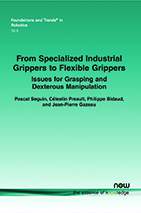From Specialized Industrial Grippers to Flexible Grippers: Issues for Grasping and Dexterous Manipulation
By Pascal Seguin, Université de Poitiers, France | Célestin Preault, Université de Poitiers, France | Philippe Bidaud, ONERA, The French Aerospace Lab, France | Jean-Pierre Gazeau, Université de Poitiers, France, jean.pierre.gazeau@univ-poitiers.fr
Abstract
The development of flexible multifingered grippers with both adaptive grasping and in-hand manipulation capabilities remains a complex issue for human-like dexterous manipulation. After four decades of research in dexterous manipulation, many robotic hands have been developed. The development of these hands remains a key challenge, as the dexterity of robot hands is far from human capabilities. Through the evolution of robotics (from industrial and manufacturing robotics to service and collaborative robotics), the monograph details the evolution of the grasping function (from industrial grippers to dexterous robot hands) and the stakes inherent today to new robotic applications in open, dynamic environments. The aim of the monograph is to assist in the choice of a grasping and manipulation solution, taking into account both the design and control aspects, from the simplest industrial gripper to the most sophisticated multidigital hands. The increasing complexity of grasping function to meet flexibility challenges led to the development of control strategies based on theoretical approaches and data-based approaches using machine learning.
From Specialized Industrial Grippers to Flexible Grippers: Issues for Grasping and Dexterous Manipulation
Since the birth of the first industrial robot in the early 1960s, robotics has often replaced humans for tedious and repetitive tasks in the industrial world. To meet these challenges, industrial robots have needed to become specialized. They have been designed according to the task that needs to be performed. In the early 1980s, the ambition to equip robots with robotic hands with universal capabilities led to the development of robotic grasping research. The emergence of more agile industry and also collaborative robotics requires the development of new generation grippers: more versatile, with not only adaptive grasping capabilities but also dexterous manipulation capabilities.
The development of flexible multi-fingered grippers with both adaptive grasping and in-hand manipulation capabilities remains a complex issue for human-like dexterous manipulation. After four decades of research in dexterous manipulation, many robotic hands have been developed. The development of these hands however remains a key challenge, as the dexterity of robot hands is far from human capabilities.
The aim of this monograph is, through the evolution of robotics from industrial and manufacturing robotics to service and collaborative robotics, to show the evolution of the grasping function. From industrial grippers to dexterous robot hands, and the stakes inherent today to new robotic applications in open, dynamic environments where humans are likely to evolve.
